Blog

Black Knight Examines Scope of Underwater Loan Rescue
In its current edition of its monthly Mortgage Monitor report Black KnightrnFinancial services takes a new look at data on underwater delinquent borrowers. The company said this was prompted by arnrecent Senate Banking Committee hearing that looked at the possibility ofrnwriting down mortgage principal balances to assist those borrowers. Trey Barnes, Black Knights senior vice president of Loan Data Products, estimated somern4 million borrowers are underwater, that is owe more on their mortgages thanrnthe market value of their homes, and have nearly $800 billion in outstandingrnbalances.</p
Evenrnin an environment of rising prices, these negative equity borrowers are tenrntimes more likely to fall into delinquency than those with positivernequity. There is a 40 percent aggregaterndelinquency rate among borrowers with current combined loan-to-value (CLTV)rnrations above 100 percent compared to 4.0 percent delinquencies for positivernequity loans. Three out of four severelyrnunderwater borrowers, those with a CLTV of 150 percent or more, are delinquent.</p
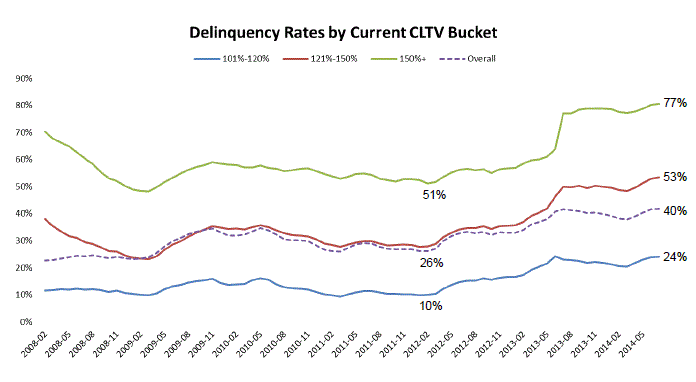 </p
</p
Evenrnwhere there is a small amount of equity delinquencies are higher. Black Knight notes in another section of the Monitor dealing with risk that borrowersrnwith LTVs of 90 percent or higher are almost six times as likely to be in defaultrn18 months after origination than those with 20 percent or more equity.</p
Therernhas been a continued improvement over the last two and a half years, as homernprices have risen, in negative equity numbers. rnOne third of mortgaged homeowners were underwater in January of 2012, arnnumber that has now declined to 8 percent. rnOnly 1.2 percent of active mortgages are currently considered severelyrnunderwater, down from 9.5 percent at the beginning of 2012 when the home pricesrnbottomed out. But as the numbers of those borrowers who are in negativernterritory has fallen, the risk for the remaining ones has increased.</p
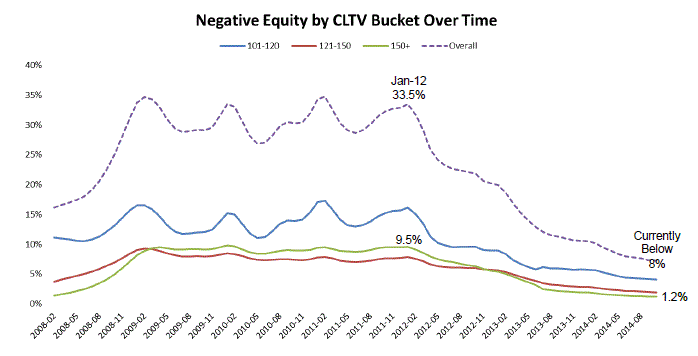 </p
</p
Focusingrnon those mortgages backed by Fannie Mae and Freddie Mac (the GSEs), which wouldrnbe those most likely to be targeted by any government write down, Black Knightrnfinds that approximately 1.3 million of them are underwater (27 million havernpositive equity) with an aggregate unpaid balance of $39 billion. The average borrower is underwater byrn$30,000.</p
Ofrnthe GSE-backed underwater loans, 365,000 of them are delinquent. These loans represent $67 billion in unpaid principalrnbalance and have an aggregate negative equity of $18 billion, an average ofrn$49,000 per loan. There is a strongrncorrelation among the GSE loans between CLTV and delinquency rates with thosernloans considered severely underwater (150+ CLTV) running a 74 percent raterncompared to 13 percent delinquencies among those with CLTVs of 101-110 percent.</p
“There is understandably arngreat deal of debate around the issue of principal reductions for theserndelinquent borrowers,” Barnes said. “With an aggregate 40 percent delinquencyrnrate among borrowers with current combined loan-to-value ratios above 100rnpercent — a number that rises to over three out of every four for severelyrnunderwater borrowers (those with CLTVs of 150 percent or higher) — the scopernand cost of such write-downs would be immense. Some $89 billion in principalrnreductions would be required to right-side these borrowers. For the 365,000rndelinquent underwater loans backed by Fannie Mae and Freddie Mac alone, nearlyrn$18 billion in write-downs would be called for.”</p
The Monitor also looked at the appetite for risk in mortgagernlending. While Black Knight finds therernhas been some easing of credit requirements for refinancing, creditrnrequirements are still historically high. rn</p
Weighted average credit scores forrnGSE refinances have come down to 742 from a high of 766 in late 2011. Creditrnrequirements on GSE purchase mortgages, on the other hand, have remained tight,rnwith average credit scores remaining relatively steady since 2009 and currentlyrnat 757. Looking at GNMA-backed originations — historically serving borrowersrnwith lower credit profiles — Black Knight again sees some relaxation inrnrefinance credit requirements, with a weighted average credit score of 701.rnThis is markedly higher, though, than the pre-crisis average of 628 in 2005.rnLikewise, credit scores on GNMA purchase loans are now an average of 703, uprnsharply from 2005’s 660 average.</p
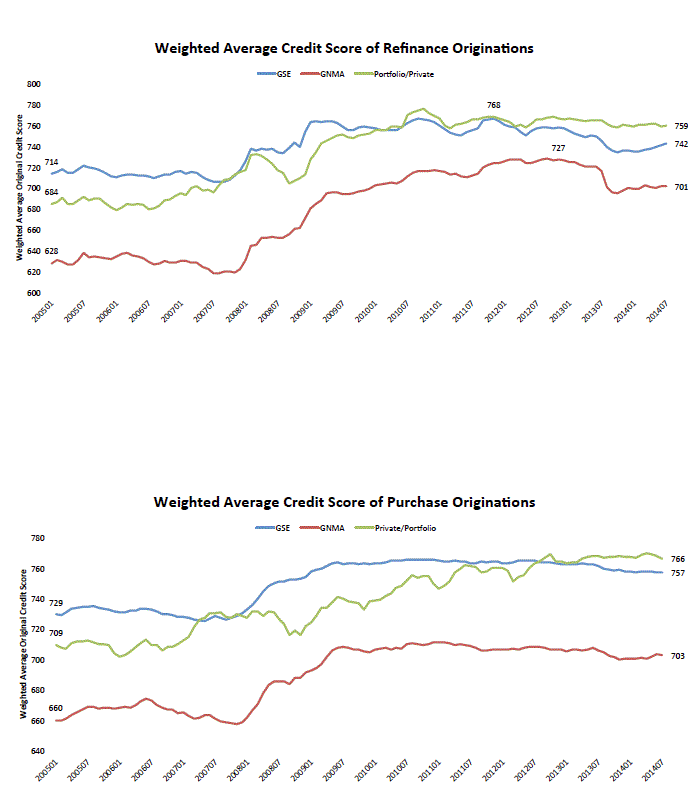 </p
</p
Looking at it from a differentrndirection, among persons refinancing in 2014 55 percent had credit scores abovern740 compared to only 29 percent in 2005 and only 8 percent had scores belowrn640, one third the number in nine years ago. rnAmong home purchase originations 56 percent went to those with thernhigher scores while only 2 percent of originations were for borrowers with scoresrnunder 640. Black Knight says, “Lowrncredit borrowers have been essentially absent in recent vintages.” At the same time, borrowers with pristine creditrncapitalized on refinances in the low interest rate environment. </p
While early stage delinquencies inrnrecent vintage loans (2012-2013) are lower for all credit score groups than inrnthe troubled 2005-2006 vintage of loans which drove much of the foreclosurerncrisis, there is still a clear difference in performance when viewed by creditrnscore.</p
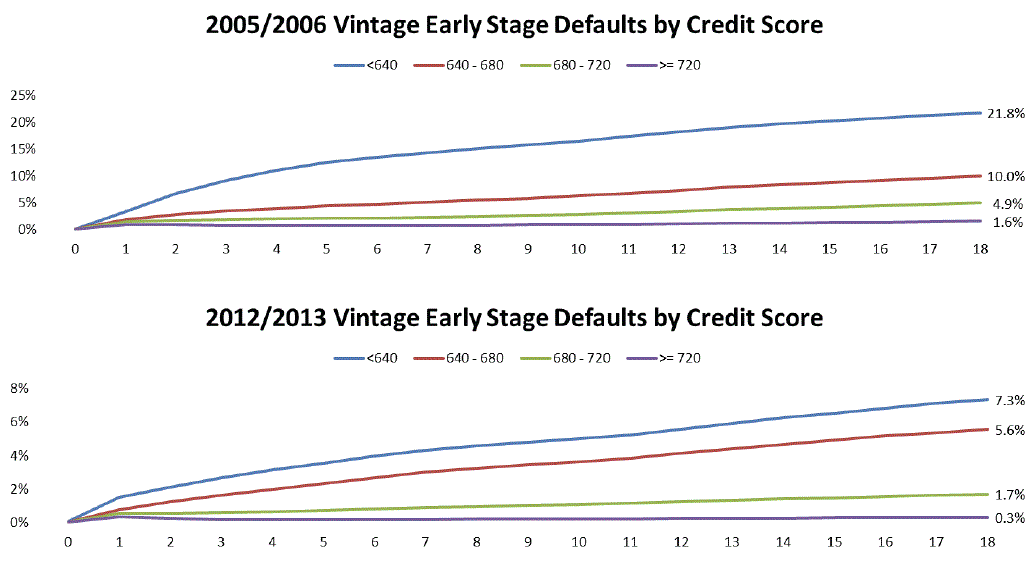 </p
</p
Returningrnto the risk of high LTV loans, Black Knight says that while lower than amongrnthe earlier vintage of loans, those recent loans with LTVs above 90 percent arernstill almost six times as likely to be in default 18 months after originationrnthan those with LTV’s of 80 percent or less.</p
Lookingrnbriefly at other data in the Monitor for October, prepayments rose slightly tornjust under 1 percent, the single month mortality or SMMM rate. This represents the percentage of totalrnoutstanding principal in a pool of loans that is prepaid in a given month. This increase in prepayments occurred asrnmortgage rates declined during the month.</p
Thernshare of mortgage originations attributed to refinancing increased from 31rnpercent in September to 42 percent in October. rnIn addition to the decrease in interest rates, Black Knight said thernpercentage of refinances generally increases in the fall and winter as homernpurchases historically decline.</p
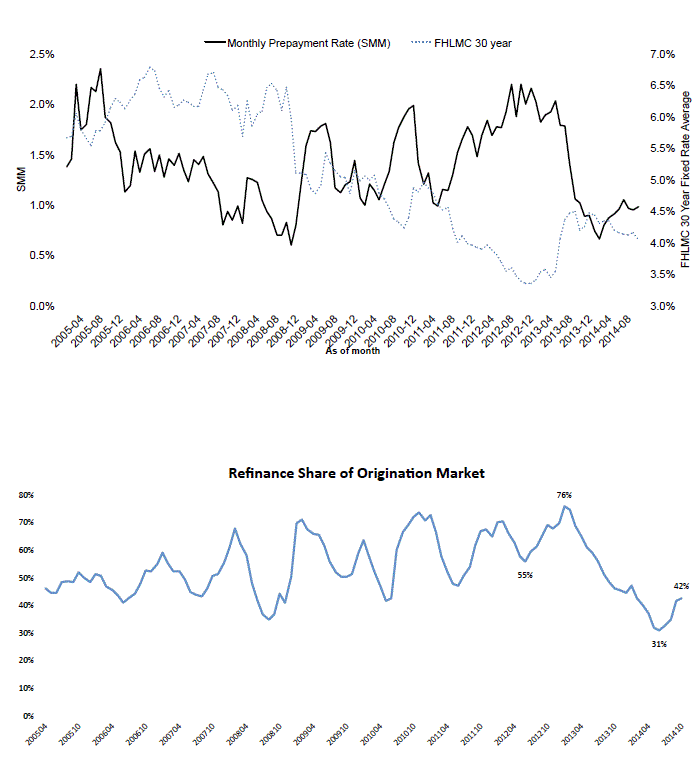
All Content Copyright © 2003 – 2009 Brown House Media, Inc. All Rights Reserved.nReproduction in any form without permission of MortgageNewsDaily.com is prohibited.
Latest Articles
By John Gittelsohn August 24, 2020, 4:00 AM PDT Some of the largest real estate investors are walking away from Read More...
Late-Stage Delinquencies are SurgingAug 21 2020, 11:59AM Like the report from Black Knight earlier today, the second quarter National Delinquency Survey from the Read More...
Published by the Federal Reserve Bank of San FranciscoIt was recently published by the Federal Reserve Bank of San Francisco, which is about as official as you can Read More...

Comments
Leave a Comment